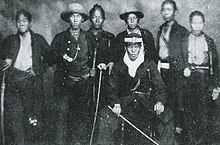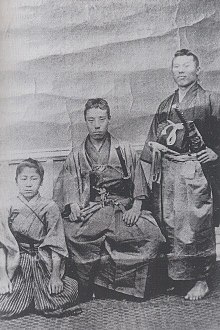| |
高杉 晉作(1839年9月27日-1867年5月17日),諱春風,通稱晉作,又名東一、和助,字暢夫,號東行。幕末長州藩士。以創設奇兵隊而活躍於倒幕活動而知名。
假名有𠔌 潛藏、 梅之助、備後屋助一郎、三𠔌和助、祝部太郎、宍戸刑馬、西浦鬆助等。之後改名為 潛蔵。贈正四位。
經歷
為長門國萩城下菊屋橫丁(現在山口縣萩市)長州藩士高杉小忠太的長男,生於天保10年8月20日。
十歳時得到皰瘡,幸而未死。嘉永5年(1852年)進入藩校的明倫館並且學習劍術。安政4年(1857年)進入由吉田鬆陰主持的鬆下村塾,安政5年(1858年)接受藩命到江戶遊學並且進入昌平坂學問所學習。安政6年(1859年),鬆陰因為安政大獄被捕而被處死刑。萬延元年(1860年)11月回鄉,與被稱為防長第一美人的山口町奉行井上平右衛門次女雅(まさ)結婚。
文久元年(1861年)3月為了訓練海軍,於是搭乘藩裏所擁有的軍艦丙辰丸前往江戶。8月前往東北遊學,和佐久間象山及橫井小楠等人結為好友。文久2年(1862年)5月受到藩命和五代友厚一起作為幕府使節隨行人員從長崎遠航到上海、當時的上海正逐漸成為英國和法國的殖民地和租界、然後晉作在見識到1854年的太平天國之亂後,7月回國,因此他的日記‘遊清五錄’被認為受到此些歷史事件很大的影響。
高杉遠航時,守舊派的長井雅樂失勢,尊攘派開始擡頭,高杉也和桂小五郎及久坂義助等人一起加入尊攘運動,於江戶和京都展開勤皇及破約攘夷的宣傳活動,並且和各藩的志士們互相交流。在這過程中,高杉和長州的志士們逐漸形成長州民族主義,而長州藩和朝廷及他藩的談判工作就由桂和久坂專門負責。文久2年(1862年)12月12日,為了抗議幕府的異敕,高杉與同志一起燒毀在品川禦殿山裏建設中的英國駐日公使館,然後把吉田鬆陰的遺骨從小塚原刑場遷葬到世田𠔌。
文久3年(1863年)5月10日,由於幕府從朝廷方面要求停止攘夷的期限已過,於是長州藩對在關門海峽外國船衹進行炮擊,高杉受委托擔任下關的防衛工作,但反而遭到美法兩國的報復攻擊而慘敗(下關戰爭)。6月在回船批發商白石正一郎的傢中組成不依據身份安排職位的奇兵隊,並且以阿彌陀寺(現赤間神宮)為根據地(但在9月的教法寺事件被罷免總監職位)。
在京都由於薩摩藩和會津藩勾結,於是對在宮廷造成“八月十八日政變”的長州藩進行放逐。文久4年(1864年)1月,高杉想要說服主張進軍京都的激進派來島又兵衛卻被其拒絶,於是高杉脫藩並且前往京都潛伏着。之後由於桂小五郎的說服而在二月歸鄉,但因為脫藩罪而被關到野山獄中,六月出獄並且遭到觀察的處分。7月,長州藩在禁門之變戰敗而成為朝敵,來島及久坂玄瑞戰死和自殺。8月時,英國、法國、美國、荷蘭所組成的四國聯合艦隊嚮下關炮撃並且占領炮臺,於是晉作遭到赦免而擔任和談的工作。
這次的和談,英國提了許多條件並且要求‘租藉彥島’。高杉大體上接受全部的條件,但對於‘租藉領土’的條件則是堅决不答應,結果是成功地讓那些國傢撤銷租藉領土的主張。或許是在中國見識到清朝遭遇的高杉深深看透‘領土附期限租藉’的意義而拒絶。伊藤博文後於其自傳憶述,如果高杉那時接受條件,將會大大改變日本歷史,而這時的高杉晉作僅僅24歳。
由於在幕府第一次長州徵伐的逼迫下,長州藩的俗論派(佐幕派)擡頭。10月,高杉逃往福岡,在躲藏於平尾山莊時,聽到屬於俗論派的正義派傢老遭處刑的事情,於是再次回去下關。12月15日的半夜,由伊藤俊輔率領的力士隊、石川小五郎率領的遊撃隊和其他長州藩諸隊在功山寺舉兵,之後奇兵隊加入這些起義隊伍。元治2年(1865年)3月,排斥俗論派的首領椋梨藤太掌握了藩的實權。同月,高杉企圖前往長崎和英國商人Glover接觸但遭到反對。4月時,由於下關開港的事件,而成為攘夷派和俗論派的目標,因此高杉和愛妾鵜野(おうの)一起逃往四國投靠日柳燕石。6月時,經由桂小五郎的斡旋而得以歸鄉。
慶應元年(1865年)1月11日,晉作遭廢嫡,在同年9月29日受藩命改名為 潛藏。慶應3年(1867年)3月29日時,被賜與新知100石,成為創立𠔌傢的初代當傢。
慶應2年(1866年)1月21日(有一說是1月22日),在土佐藩的坂本竜馬、中岡慎太郎、土方久元的中介下,晉作和桂小五郎、井上聞多、伊藤俊輔一起在京都和薩摩藩組成薩長同盟。
5月時,與伊藤俊輔一起被命令前往薩摩,並且在長崎單獨買下了丙寅丸。
在6月的第二次長州徵伐擔任海軍總督並擊退幕府艦隊,奪回了周防大島。而在小倉方面,於序盤攻勢時與肥後藩在小倉城的戰鬥勢均力敵,使得長州藩的局勢一度呈現好轉的狀態。
由於幕府軍總督小笠原長行膽小寡斷而激怒了加入幕府軍的諸藩們,他們威脅隨時要撤兵。7月時則因為收到將軍德川傢茂死去的消息,使得小笠原决定撤退,此事因此决定了幕府的敗戰。這次的敗戰使得幕府的權威大大的墜落,成為慶應3年(1867年)11月大政奉還的巨大轉捩點,但是晉作自己卻在此時患了肺結核,於是不得不在櫻山展開療養生活。同年的5月17日(慶應3年4月14日),還未見到大政奉還的高杉過世,得年27歲。臨終時有父母和妻兒在身旁陪他,並且據說野村望東尼和山縣狂介、田中顯助等人也在高杉臨死前和他見過面,但根據田中殘餘的日記來看,他那時人正在京都,所以詳情不明。高杉之墓位於現在的山口縣下關市。
後來因為木戶孝允和大村益次郎等人的要求,於是高杉和吉田鬆陰、久坂玄瑞、坂本竜馬及中岡慎太郎等人,一起被迎接進入現在的靖國神社受到表彰和祭拜。
高杉的辭世之句為“面白き 事も無き世を 面白く”(讓這無趣的世界變得有趣吧)。
在他的彰顯碑上寫着:“動如雷電、發如風雨、衆目駭然、無敢正視者、此非我東行高杉君哉。” 這是伊藤博文對高杉晉作所作的評價。
登場作品
- 小說
- 棲世之日(文藝春秋、司馬遼太郎著)
- 第十一位志士(文藝春秋、司馬遼太郎著)
- 高杉晉作(講談社、山岡莊八著)
- 高杉晉作(學研、三好徹著)
- 晉作 蒼藍烈日(NHK出版、秋山香乃著)
- 高杉晉作(講談社、池宮彰一郎著)
- 青年(中央公論新社、林房雄著)
- 高杉晉作奔突(講談社、古川薫著)
- 高杉晉作~戰鬥者的愛與死~(新潮社、古川薫著)
- My Dear Shinsaku(新潮社、今江祥智著)
- 影視劇
- 决戰奇兵隊(1941年、日活、演:嵐寛壽郎)
- 風雲千兩船(1952年、東寶、演:長𠔌川一夫)
- 幕末太陽傳(1957年、日活、演:石原裕次郎)
- 高杉晉作(1963年、ANB、演:宗方勝巳)
- 幕末(1964年、TBS、演:木村功)
- 三姊妹(1967年、NHK大河劇、演:山本學)
- 少年高杉晉作(1967年、NET、演:加藤剛)
- 第十一位志士(1968年、NET、演:平幹二朗)
- 竜馬來了(1968年、NHK大河劇、演:和田浩治)
- 吉田鬆陰(1969年、KTV、演:高橋長英)
- 天皇的世紀(1971年、ABC、演:原田大二郎)
- 清水次郎長(1971年、CX、演:古𠔌一行)
- 花神(1977年、NHK大河劇、演:中村雅俊)
- 風在燃燒(1978年、TBS、演:山口崇)
- 幕末青春塗鴉:坂本竜馬(1982年、NTV、演:吉田拓郎)
- 竜馬來了(1982年、TX、演:田村亮)
- 大奧(1983年、KTV、演:大橋吾郎)
- 服部半藏 影之軍團(1985年、KTV、演:本田博太郎)
- 奇兵隊(1989年、NTV、演:鬆平健)
- 坂本竜馬(1989年、TBS、演:井上純一)
- 野心之國(1989年、NTV、演:陣內孝則)
- 宛如炎光 吉田鬆陰(1991年、KRY、演:中西良太)
- 拜托竜馬了!(1996年、NTV、演:寺脅康文)
- 竜馬來了(1997年、TBS、演:西村和彥)
- 尾張幕末風雲錄(1998年、TX、演:篠塚勝)
- 蒼天之夢(2000年、NHK、演:野村萬齋)
- 竜馬來了(2004年、TX、演:葛山信吾)
- 長州五傑(2006年、Libero、演:寺島進)
- 獄中花開(2010年、Thanks Lab、演:南譽士廣)
- 竜馬傳(2010年、NHK大河劇、演:伊勢𠔌友介)
- 鮮為人知的幕末志士:山田顯義物語(2012年、MBS、演:桐山照史)
- 花燃(2015年、NHK大河劇、演:高良健吾)
- 舞臺
- 歌謠
- 漫畫
- 跑吧晉作(角川書店、橋本光男作)
- 夕凪(角川書店、杉本亞未作)
- 萩生養的少年志士:吉田鬆陰與其門下生(齊藤榮一作)
- 喂!竜馬(小學館、武田鐵矢作・小山由畫)
- SIDOOH 士道(集英社、高橋努作)
- 仁者俠醫(集英社、村上紀香作)
- 神劍闖江湖(集英社、和月伸宏作)
- 銀魂(集英社、空知英秋作)
- 無敵怪醫K(講談社、真船一雄作)
- 竜馬へ(講談社、陸奧利之作)
- 爆彈!〜幕末男子〜(講談社、加瀨敦作)
- 魔女三百纔開始(白泉社、原田重光作・鬆本救助畫)
- 遊戲
- 明治維新
- 維新之嵐
- 維新之嵐:幕末志士傳
- 坂本竜馬・維新開國
- 風雲:幕末傳
- 遙遠時空
- 裏語 薄櫻鬼
- 在茜色天空與君詠唱
- 幕末ROCK
Takasugi Shinsaku (高杉 晉作, 27 September 1839 – 17 May 1867) was a samurai from the Chōshū Domain of Japan who contributed significantly to the Meiji Restoration. He used several alias to hide his activities from the Tokugawa shogunate.
Early life
Takasugi Shinsaku was born in the castle town Hagi, the capital of the Chōshū Domain (present-day Yamaguchi Prefecture) as the first son of Takasugi Kochuta, a middle-ranked samurai of the domain and his mother Michi (道). He would have three younger sisters by the name of Tomo (智), Sachi (幸) and Mei (明). He had smallpox at the age of ten, but fortunately he had recovered from it.
Takasugi joined the Shoka Sonjuku, the famous private school of Yoshida Shōin. Takasugi devoted himself to the modernization of Chōshū's military, and became a favorite student of Yoshida. In 1858, he entered the Shōheikō (a military school under direct control of the shōgun at Edo). When his teacher was arrested during the Ansei Purge in 1859, Takasugi visited him in jail. Shōin was later executed in 21 November 1859. In December 1859 he returned home by the clan's command.
In January 1860, Takasugi married Inoue Masa, the second daughter of Yamaguchi retainer and magistrate Inoue Heiemon who was also the friend of his father. Masa was said to be the most beautiful lady in Suō and Nagato provinces. Their marriage was arranged by his parents, with hope that he would take his mind off of his teacher's death in 1859 and to settle down with his new bride.
However, in April 1861, Takasugi would left his home and undertook naval training on the clan's warship Heishinmaru, and travelled to Edo. Later in September he went to study at the Tōhoku region, and there he was associated with Sakuma Shōzan and Yokoi Shōnan.
Foreign experience
Takasugi, in spite of his young age, was an influential factor within Chōshū as one of the most extreme advocates of a policy of seclusion and expelling the foreigners from Japan. Takasugi was implicated in the 31 january 1863 attack on the British legation in Edo.
In spite of Japan's policy of national isolation in the Edo period, in 1862 Takasugi was ordered by the domain to go secretly to Shanghai in China to investigate the state of affairs and the strength of the Western powers. Takasugi's visit coincided with the Taiping Rebellion, and he was shocked by the effects of European imperialism even on the Chinese Empire. Takasugi returned to Japan convinced that Japan must strengthen itself to avoid being colonized by the western powers, or to suffer a similar fate as China. This coincided with the growing Sonnō Jōi ('expel the barbarians and revere the Emperor') movement, which attracted certain radical sections of Japan's warrior class and court nobility, and Takasugi's ideas found ready support in Chōshū and other parts of Japan.
Formation of the Shotai and Kiheitai
Takasugi originated the revolutionary idea of auxiliary irregular militia (shotai). Under the feudal system, only the samurai class was allowed to own weapons. Takasugi promoted the recruitment of commoners into new, socially-mixed paramilitary units. In these units, neither recruitment nor promotion depended (at least in theory), on social status. Farmers, merchants, carpenters and even sumo-wrestlers and Buddhist priests were enlisted, although samurai still formed the majority in most of the Shotai. Takasugi clearly saw that utilization of the financial wealth of the middle-class merchants and farmers could increase the military strength of the domain, without weakening its finances. Since the leaders of Chōshū were unable - and unwilling - to change the social structure of the domain, limited use of peasants and commoners enabled them to form a new type of military without disturbing the traditional society.
In 1863, Takasugi himself founded a special Shotai unit under his direct command called the Kiheitai, which consisted of 300 soldiers (about half of whom were samurai). However, due to his propagation of Sonnō Jōi ideology, Takasugi was imprisoned by the domain's authorities, after an anti-Chōshū coup in Kyoto in the summer of 1863 threatened to jeopardize Chōshū's leading role in national politics.
External and internal crisis
However, Chōshū soon had no choice but to call on Takasugi again. After Chōshū fired upon Western warships in the Straits of Shimonoseki on 25 June 1863, British, French, Dutch and American naval forces bombarded Shimonoseki, the main port of the Chōshū domain the following summer in what was later called the Bombardment of Shimonoseki. This was followed by the landing of French marines. Their fighting against Chōshū units demonstrated the inferiority of traditional Japanese troops against a Western army, and convinced the leaders of the domain of the absolute necessity for a thorough military reform. The Chōshū domain's administration called on Takasugi not only to carry out this reform as ‘Director of Military Affairs’, but he - only 25 years of age - was also entrusted with negotiating peace with the four Western powers.
In view of the humiliation of Chōshū forces against the Western powers, Takasugi had come to the realization that direct confrontation with the foreigners was not an option. Instead, Japan had to learn military tactics, techniques and technologies from the West. Takasugi reorganized his Kiheitai militia into a rifle-unit with the latest modern rifles, and introduced training in Western strategy and tactics. Moreover, Takasugi used his influence with the Sonnô Jôi-movement to promote a more a conciliatory policy towards the West and thus, the ‘movement to expel the barbarians and revere the Emperor’ evolved into an anti-Bakufu movement with the overthrow of the Tokugawa Bakufu as a necessary means to strengthen Japan against the foreigners.
Weakened by the punitive attack by the Western powers, Chōshū was unable to withstand an expedition mounted by the Bakufu in autumn 1864 in retaliation for previous Chōshū attempts to seize control of Kyoto. At first, conservative forces, which favored conciliation with the Bakufu in order to secure the domain, were dominant in Chōshū politics, and Takasugi and some of his compatriots had to leave the domain to avoid renewed imprisonment. Takasugi, with only about a dozen followers, including future political leaders Yamagata Aritomo, Itō Hirobumi and Inoue Kaoru, gathered in Kokura in Kyūshū and prepared an attack on the conservative forces in Chōshū. The subsequent Chōshū civil war began on 13 January 1865.
Takasugi played a major role in this civil war and his Kiheitai militia proved its superiority over old-fashioned samurai forces. With a series of quick strikes and the support of Katsura Kogorō, Takasugi achieved victory by March 1865. He became one of the main arbiters of the Chōshū domain's policy and continued to act as the domain's expert on Western military science, devoting his efforts to importing arms and raising troops. These reforms proved to be successful when Chōshū was victorious on four fronts against the Bakufu's Second Chōshū expedition in 1866, with the Kiheitai itself securing victory on two fronts. Takasugi's efforts had made a small-scale ‘nation in arms’ out of Chōshū, giving it a military strength out of proportion to its relatively small size. With its victory over the Tokugawa forces, the military power of the Bakufu was discredited, and traditionally rival domains decided to join forces with Chōshū in the subsequent battles which led to the Meiji Restoration and the end of the Tokugawa Bakufu.
Death
Takasugi did not live to see this success. He died of tuberculosis in the residence of the bar manager Hayashi Sankuro at Shimonoseki on 17 May 1867, while under the care of his former mistress O-Uno and his wife Masa. His Kiheitai was taken over by his protégé Yamagata Aritomo. Only a year later, Takasugi's dream of overthrowing the Tokugawa Shogunate, which found obvious manifestation in his alternate name Tōgyō (Go to the East) - was fulfilled with the Meiji Restoration.
The Kiheitai was disbanded in 1868, the success of the socially mixed unit and its Western armaments and tactics was an important influence on the development of the Imperial Japanese Army, and on the later system of universal military conscription in Japan.
Legacy
Takasugi Shinsaku, a central figure of the early Meiji Restoration, is as well known for his military talents as he is for his skills as a politician. However, dying at the young age of 28, Takasugi was not to become one of Japan's famous leaders in the subsequent Meiji era. In his hometown - the castle town Hagi, Yamaguchi in south-western Japan - he is still remembered as a mystical and energetic hero, who put all his efforts into opening the way to modernization, westernization and reforms, not only in military matters but in political and social matters as well.
Court rank
- Shoshi’i (正四位, Senior Fourth Rank)
Gallery of birthplace of Takasugi Shinsaku
Takasugi Shinsaku in media
- Takasugi is a secondary character present in the manga and anime Rurouni Kenshin, as well as its OAV adaptation Trust and Betrayal, shown to be in the last stages of his illness. He recruited the young Himura Kenshin into the Kiheitai before allowing Chōshū leader Katsura Kogorō to make him the Hitokiri Battōsai. While portrayed as a brash and ruthless warrior, he is nonetheless wary of his unsavory actions and tried to dissuade Katsura from "corrupting" Kenshin's soul, to no avail. His Japanese voice actor is Wataru Takagi, and his English voice actor is Jason Phelps.
- Takasugi was the inspiration for Takasugi Shinsuke, one of the main and earliest antagonists in the manga series Gin Tama.
- A highly fictionalized version of Takasugi appears in the PSP game Bakumatsu Rock and its anime adaptation. In the game, which is set in the Bakumatsu and has a musical theme, he is depicted as the bass player in a rock band led by Sakamoto Ryōma.
- Takasugi Shinsaku is usually portrayed in most NHK Taiga drama dealing with the Meiji Restoration. Most recent instances would be:
- Ryōmaden, played by Japanese actor Yusuke Iseya
- Hana Moyu, played by Japanese actor Kengo Kora.
- Takasugi Shinsaku was played by Japanese actor Yujiro Ishihara in the 1957 film Sun in the Last Days of the Shogunate.
- Takasugi Shinsaku is credited with the aphorism "Live a pleasant life in the unpleasant world" in the manga Natsuyuki Rendezvous.
- Takasugi Shinsaku is the protagonist in the anime "Bakumatsu".His Japanese voice actor is Nakamura Yuuichi.
Notes
- ^ "The Togyoan Hermitage & Memorial Museum (gravesite of Takasugi Shinsaku)(Yamaguchi) | JAPAN TIMELINE ~See what is happening in Japan now~". JAPAN TIMELINE. Retrieved 2018-07-19.

















